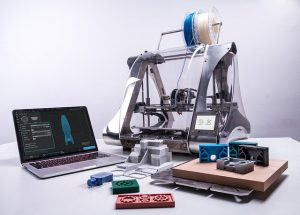
Thermoplastic is the most common material from which 3D printers build objects. Nearly all fused filament fabrication (FFF) 3D printers use a spool of thermoplastic filament. During operation, the FFF 3D printer will feed the filament into its nozzle head. As the filament is forced into the nozzle head, it’s extruded and released onto the print bed, thus building the object. Why do so many 3D printers use thermoplastic exactly?
What Is Thermoplastic?
Thermoplastic is defined as any polymer-based material that becomes moldable when exposed to heat and reverts back to a solid and hard consistency when cooled. It’s solid in its default state. When heated, though, thermoplastic material becomes softer and more pliable. It will then change to a solid state once the thermoplastic material has cooled.
Supports Extrusion
Thermoplastic material can be extruded, which is a necessary process for FFF 3D printers to build objects. FFF 3D printers have a nozzle head through which thermoplastic filament is extruded. The filament is fed into the nozzle where a patterned extrusion component gives it a cross-sectional profile. The extruded filament will then land in a specific area of the print bed to build the object layer by layer.
Variety of Colors
Another reason 3D printers use thermoplastic material is because it allows for a variety of colors. Thermoplastic material isn’t restricted to a single color. Rather, it can be dyed to achieve nearly any color. And since 3D printed objects are often colored, 3D printers use thermoplastic material.
Allows for Transparency
In addition to a variety of colors, thermoplastic material can be transparent. If the object is designed to be see-through, a transparent material will be required. Thermoplastic is one such material that allows for transparency.
No Adhesives Needed
Thermoplastic material eliminates the need for adhesives. As previously mentioned, it changes from a semi-liquid to a solid state when cooled. There are other materials from which 3D printers can build objects. Unfortunately, many of them require the use of adhesives. If the material doesn’t harden on its own, an adhesive may be required. Thermoplastic material doesn’t require the use of an adhesive since it hardens when cooled.
Low Cost
Thermoplastic material is relatively inexpensive. Like with most materials, prices can fluctuate. Some thermoplastic material may cost less than $1 per pound, whereas other thermoplastic material may cost over $10 per pound. Regardless, it generally costs less than other materials used in 3D printing applications.
No tags for this post.